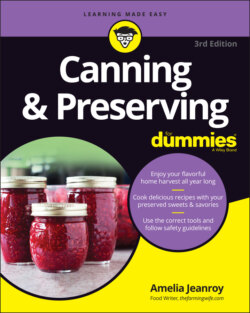Читать книгу Canning & Preserving For Dummies - Amelia Jeanroy - Страница 17
Canning methods to avoid
ОглавлениеOlder canning methods are unreliable and, for that reason, aren’t used or recommended today for home-canning. Occasionally, these methods are “revived” as being faster and easier than water-bath or pressure canning, but using any of the following methods is like playing Russian roulette with your food safety. Just because your grandmother used one of the following methods doesn’t make it safe to use today. If you see instructions that require you to use any of the following methods, do yourself a favor and pass by that recipe.
Oven method: In this method, filled jars are placed in a hot oven. The method is unsafe because your food’s internal temperature most likely won’t become hot enough to destroy microorganisms and other bacteria that cause spoilage. There’s just no guarantee that the food in the jars will reach the temperature you set your oven at. There’s also a chance that your jars may explode from the sudden temperature change when your oven door is opened.
Dry canning: In this method, products such as flour and beans are placed in traditional canning jars and the jars are heated at a low temperature. The lids are applied either before heating or after the jars are removed from the oven. Heating dry goods in this manner is unsafe for two reasons. First, heating dry foods releases any moisture that is naturally still in the food. This moisture can develop mold, and other pathogens that are dangerous to ingest. Second, higher-fat foods such as nuts and grains will deteriorate more quickly after being subjected to heat. This deterioration causes the food to become rancid.
Open-kettle method: In this method, food is cooked in an open pot and transferred to sterilized jars. The two-piece caps are quickly added in hopes of sealing the jars as the food cools. This process produces a low vacuum seal that may be broken as gas from spoiling food builds up in the jar. This occurs because your food isn’t heated to destroy microorganisms. There’s also a chance your food may become contaminated when transferring it into the jars.
Steam method: This method uses a shallow, covered pan with a rack in the bottom. After the filled jars are placed in the pan, steam circulates around the jars. This method is unsafe because the jars aren’t evenly heated and the steam isn’t pressurized to superheat the food and destroy microorganisms. Don’t confuse this method with pressure canning.
Microwave oven: All microwave ovens heat differently. Because of this, there’s no way to set standards for processing times that achieve a high enough temperature to penetrate the jars and destroy microorganisms that cause food spoilage.
Dishwasher: Because there’s no way to know the exact temperature of different dishwashers and because temperature fluctuates throughout the cleaning cycle, dishwasher canning is a no-no. You can’t rely on it to produce a safely canned product. You can, however, use a dishwasher to wash your jars and let them sit in the hot dishwasher until you’re ready to fill them.
Aspirin: Don’t laugh at this, but at one time, aspirin was used as a substitute for heat processing. It does contain a germicidal agent that acts as a preservative, but this agent doesn’t destroy the enzyme that causes deterioration in food and food spoilage.
Wax or paraffin seal: Using wax or paraffin was once thought of as a safe way to seal canned goods. It has been proven to be unreliable, and dangerous botulism spores can still develop.
